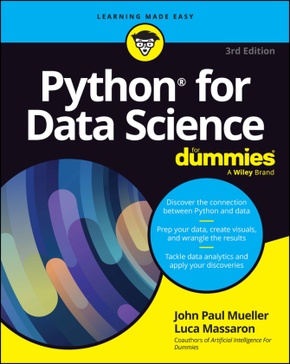
Python for Data Science For Dummies
| Verlag | Wiley & Sons |
| Auflage | 2023 |
| Seiten | 464 |
| Format | 19,1 x 2,5 x 23,8 cm |
| Gewicht | 866 g |
| Artikeltyp | Englisches Buch |
| EAN | 9781394213146 |
| Bestell-Nr | 39421314UA |
Let Python do the heavy lifting for you as you analyze large datasets
Python for Data Science For Dummies lets you get your hands dirty with data using one of the top programming languages. This beginner's guide takes you step by step through getting started, performing data analysis, understanding datasets and example code, working with Google Colab, sampling data, and beyond. Coding your data analysis tasks will make your life easier, make you more in-demand as an employee, and open the door to valuable knowledge and insights. This new edition is updated for the latest version of Python and includes current, relevant data examples.
_ Get a firm background in the basics of Python coding for data analysis
_ Learn about data science careers you can pursue with Python coding skills
_ Integrate data analysis with multimedia and graphics
_ Manage and organize data with cloud-based relational databases
Python careers are on the rise. Grab this user-friendly Dummies guide and gain the programming skills you need to become a data pro.
Inhaltsverzeichnis:
Introduction 1
Part 1: Getting Started with Data Science and Python 7
Chapter 1: Discovering the Match between Data Science and Python 9
Chapter 2: Introducing Python's Capabilities and Wonders 21
Chapter 3: Setting Up Python for Data Science 33
Chapter 4: Working with Google Colab 49
Part 2: Getting Your Hands Dirty with Data 71
Chapter 5: Working with Jupyter Notebook 73
Chapter 6: Working with Real Data 83
Chapter 7: Processing Your Data 105
Chapter 8: Reshaping Data 131
Chapter 9: Putting What You Know into Action 143
Part 3: Visualizing Information 157
Chapter 10: Getting a Crash Course in Matplotlib 159
Chapter 11: Visualizing the Data 177
Part 4: Wrangling Data 199
Chapter 12: Stretching Python's Capabilities 201
Chapter 13: Exploring Data Analysis 223
Chapter 14: Reducing Dimensionality 251
Chapter 15: Clustering 273
Chapter 16: Detecting Outliers in Data 291
Part 5: Learning from Data 305
Chapter 17: Exploring Four Simple and Effective Algorithms 307
Chapter 18: Performing Cross-Validation, Selection, and Optimization 327
Chapter 19: Increasing Complexity with Linear and Nonlinear Tricks 351
Chapter 20: Understanding the Power of the Many 391
Part 6: The Part of Tens 413
Chapter 21: Ten Essential Data Resources 415
Chapter 22: Ten Data Challenges You Should Take 421
Index 431
